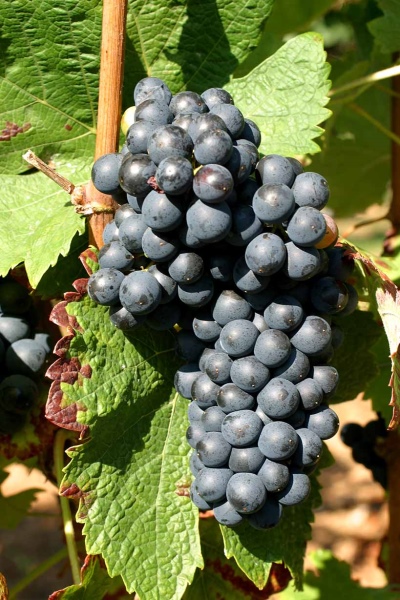
- Authors: France
- Appointment: technical
- Berry color: black
- Taste: harmonious
- Ripening period: average
- Frost resistance, ° C: -18
- Name synonyms: Shiraz, Series, Servan black, Petit Sira, Hermitage
- Flower type: bisexual
- Density of the bunch: medium density
- Appeared when crossing: Mondez Blanche x Dureza
Shiraz is the sixth most popular grape variety in the world. Suitable for making red and rosé wines with a unique and exquisite bouquet. Known under the names: Seri, Serine, Cervan black, Petit Syrah, Hermitage, Kandiv, Marsanne Noir, Inin Noir, Antourneren, Plan de la Bion, Bion, Balsamina, Rossissimo, Uvino, Lancelotta, Ancelotta.
Breeding history
One of the most ancient varieties. The exact date of appearance has not been set. The origin was determined using DNA analysis. Geneticists have established: the variety originated from a mixture of red Durez grapes and white Maudez Blanche in the North Rhone area (South-East France).
Geography of distribution
Cultivated on the territory of Russia in the Krasnodar Territory, in the Crimea: the valleys of Alma, Kacha, Belbek.
Description
The Shiraz variety is grown for winemaking. It is characterized by low yield. Withstands temperature extremes, changing weather, resistant to a number of diseases. Adapts to different climatic conditions.
Differs in moderate growth force. Typical are medium-sized bushes with small rounded leaves with three or five lobes, moderately dissected below, slightly pubescent. The surface of the leaf is shiny, bright green with light veins. When it gets colder, buds and ovaries may crumble.
Ripening period
The variety blooms late, but the berries ripen quickly. Refers to medium-late varieties: the period of fruit formation is 145-160 days. You can harvest from August.
Bunches
The brushes are compact, in the form of a conical cylinder, not very dense. The berries are not peas. Weighing from 115 to 150 g.
Berries
Bluish-black, medium-sized, slightly oval, covered with a thick bluish bloom. Diameter from 1.2-2 cm, and weight from 1.3-2.3 g. The skin is thick, rich in tannins and dyes. The pulp is juicy, light, not colored, the bones are small. Pure juice content - 75% of the total weight of the fruit.
Taste
Harmonious, concentrated, blackberry notes are heard in the aroma and aftertaste. Contains a lot of sugar - 200 g per 1 dm3, moderately acidic - 5.5-6.5 g per 1 dm3. Flavoring shades change with age: young grapes have spicy-peppery notes, while a 10-year-old vine develops shades of black fruit.
Yield
Quite good yield indicators - 2-3 clusters are formed on one vine. To obtain drinks with high taste, it is necessary to limit fruiting. If ripe brushes are not collected in time, then a special aroma and astringency are lost.


Growing features
Favorable average daily temperature for growing is +17 degrees Celsius. Grows on any type of soil. Depending on the area of cultivation, it acquires new flavors. Fruiting for over a hundred years.
Landing
Planted in areas protected from the wind. Support and a warm, sunny location, preferably on a slope, are required. Sudden changes in temperature affect the timing of ripening. Grows well on soils containing active limestone. If the groundwater is close, it is recommended to make drainage.
Planted in spring or autumn before the onset of cold weather. The garden bed is dug up, potash fertilizers, compost, humus are applied under each seedling.

Pollination
It has bisexual flowers that are well pollinated. During flowering, the temperature should not drop below +14 degrees. After pollination, the ovaries appear late. In unfavorable weather, some of the flowers do not develop into an ovary and a berry.
Pruning
Dry, damaged vines are pruned before the buds swell. Spring long shoots must be cut, leaving the strongest ones. In summer, the tips are pinched so that they do not grow more than 1.7 m.After harvest, they are also pruned. For the winter, make a short pruning.

Watering
Plants do not tolerate low moisture levels in the soil. Plants require root irrigation: 4-5 buckets per bush every two weeks. The ideal option is drip irrigation.


Top dressing
It is carried out several times per season: in early spring, before the buds swell - humus and superphosphate 10: 1, after flowering - an aqueous solution with superphosphate and saltpeter, after the formation of ovaries - liquid organic fertilizers. In the absence of rain, it is sprayed every 2 weeks with a urea solution when pouring bunches. After harvesting, they are fed by the root method with a manure solution.
Frost resistance and the need for shelter
Does not differ in frost resistance, up to -22 degrees, does not tolerate frost well. A high-quality shelter for the winter is recommended, a lighter variety is made for spring. For the winter, they are laid on rack structures, covered with spruce branches or geotextiles on top.

Diseases and pests
Prone to chlorosis. It is affected by ticks and gray rot. The foliage is sprayed with insectoacaricides. To a moderate extent opposed to mildew and oidium. In the spring, they are treated with special means, near the trunk circle they sprinkle nitrophoska, "Kemira", watered abundantly.

If a grape is exposed to any disease or insect, this always affects its appearance.
Storage
The collected bunches are stored in a cool place for 4-5 months without losing their appearance and taste. Withstand long-term transportation.











































































